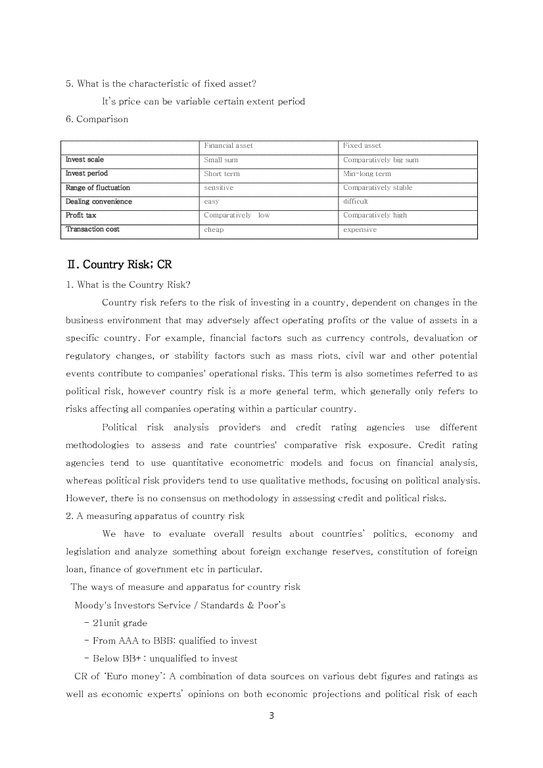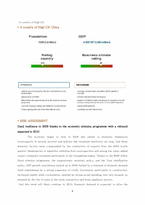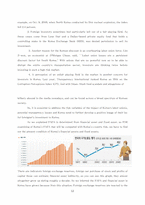[국제금융론] The relationship between FAFA and CR(영문)
 등록일 / 수정일
등록일 / 수정일 페이지 / 형식
페이지 / 형식 자료평가
자료평가 구매가격
구매가격
- 2011.01.18 / 2019.12.24
- 15페이지 /
 docx (MS워드 2007이상)
docx (MS워드 2007이상) - 평가한 분이 없습니다. (구매금액의 3%지급)
- 1,400원
최대 20페이지까지 미리보기 서비스를 제공합니다.
자료평가하면 구매금액의 3%지급!
 1
1 2
2 3
3 4
4 5
5 6
6 7
7 8
8 9
9 10
10 11
11 12
12 13
13 14
14 15
15
추천 연관자료
- 목차
-
Ⅰ. FAFA
Ⅱ. Country Risk; CR
1. What is the Country Risk?
2. A measuring apparatus of country risk
3. Cause of CR’s Occurrence
4. CR of Countries
Ⅲ. The relationship between FAFA and CR in Latin America Countries
Ⅳ. The relationship FAFA and CR in Korea
Ⅴ. Conclusion
Bibliography
- 본문내용
-
A country of High CR
▪ A country of High CR: China
▪ RISK ASSESSMENT
Good resilience in 2009 thanks to the economic stimulus programme with a rebound expected in 2010
The economy began to slow in 2008 due mainly to domestic imbalances (overcapacity in several sectors) and policies that remained restrictive too long. And these domestic factors were compounded by the contraction of exports from the 2008 fourth quarter. Bankruptcies in industries suffering from overcapacities and among low value-added export companies increased particularly in the Guangdong region. Thanks to the $586 billion fiscal stimulus programme, the expansionary monetary policy, and the Yuan stabilization policy, GDP growth nonetheless picked up in 2009 fuelled by a rebound of domestic demand itself underpinned by a strong expansion of credit. Investment, particularly in construction, increased rapidly while consumption, spurred by strong social spending, was very dynamic as attested by the rise of sales in the retail, automotive and home appliance sectors.
And this trend will likely continue in 2010. Domestic demand is expected to drive the economy with the net contribution of exports to growth expected to be near zero. A tightening of fiscal and monetary policy and acceleration in the pace of the Yuan appreciation will not likely be decided before the second half of the year.
Persistent weaknesses: risk of overcapacity and risk of default will bear watching in 2010
Default risk will continue to bear watching in some sectors, particularly low value-added sectors (textiles, shoes, toys) and sectors grappling with overcapacity (automotives, construction, steel), with the government working to move the economy up market. And with the stimulus program spurring investment, the risk of overcapacity will remain a central weakness of the Chinese growth regime in the medium term. The risk of speculative bubbles in the property and stock markets will likely remain limited. Strong demand in the property market naturally puts pressure on prices accentuated by the effects of the restrictive policy pursued by the government in 2007-2008, which delayed, even froze many projects and thus slowed the growth of supply. Furthermore, the demographic trend, urbanization, and middle class aspirations for more modern housing will durably support the property market. Meanwhile, despite the strong recovery of the Shanghai composite index, stock market capitalization in relation to GDP is far lower in China (32%) than it is in Japan (67%) or the United States (87%), which would mitigate the macroeconomic consequences of a possible crisis.
Strong financial position
China's financial position remains strong. The current account surplus will remain high this year despite a more rapid recovery of imports than exports (associated with the rebound of intermediate goods assemble in China). Foreign exchange reserves will thus remain very high.
Banking risk, however, has been increasing. After successive reductions of interest rates and the lifting of quotas on loans, the expansion of credit accelerated significantly in 2009. In a context of relatively lax risk management, asset quality will be likely to deteriorate with the amount of non-performing loans increasing. With the government ready, however, to recapitalize banks if necessary, systemic risk will nonetheless remain limited.
Deficiencies in the business environment
In the political arena, social risk has been growing in both rural and urban areas. The government is nonetheless expected to be able to hold social movements in check. Major governance shortcomings persist despite the recent progress in the regulatory framework.
6. Country risk and exchange rate correlation
The exchange risk associated with a foreign denominated instrument is a key element in foreign investment. This risk flows from differential monetary policy and growth in real productivity, which results in differential inflation rates. For example, if you are a U.S. investor and you have stocks in Canada, the return that you will realize is affected by both the change in the price of the stocks and the change of the Canadian dollar against the U.S. dollar. Suppose that you realized a return in the stocks of 15% but if the Canadian dollar depreciated 15% against the U.S. dollar, you would make a small loss.
Ⅲ. The relationship between FAFA and CR in Latin America Countries
When a firm conducts transactions in different currencies, it exposes itself to risk. The risk arises because currencies may move in relation to each other. If a firm is buying and selling in different currencies, then revenue and costs can move upwards or downwards as exchange rates between currencies change. If a firm has borrowed funds in a different currency, the repayments on the debt could change or, if the firm has invested overseas, the
- 참고문헌
-
Bibliography
1. http://www.coface.com
2. http://en.wikipedia.org
3. http://commons.wikimedia.org
4. http://www.koreatimes.co.kr
5. http://ecos.bok.or.kr
6. http://news.naver.com
자료평가
-
아직 평가한 내용이 없습니다.
오늘 본 자료
더보기

최근 판매 자료
- 시장조사론_외생변수란 무엇이며, 왜 문제가 되는지 강의내용을 중심으로 작성하시오
- 소비자심리학_코로나가 발생하기 전과 후의 소비자 심리의 변화를 자신의 구매행동을 사례를 들어 작성하세요
- [마케팅전략] 아디다스 전략적 분석 및 지속성장을 위한 제언
- 근현대 한국사회 발전과 갈등을 정치사와 경제사의 상호관련성 아래 분석하고, 이를 서구의 민주화 및 산업화와 비교하여 설명하시오
- [경영]페덱스 서비스경영
- [경영전략] 마이클 포터의 5 Force모델에 따른 미스터피자 분석
- 신제품 개발 성공사례와 개인적인 견해 (개념, 조건, 과정)
- [경영사례 분석]PDG세대를 겨냥한 감성 마케팅, 텐바이텐
- [e비즈니스]인터넷쇼핑몰 `텐바이텐` 마케팅전략 및 성공요인 분석(A+리포트)
- [특수마케팅이론과 사례] 유통마케팅-감성으로 말하는 텐바이텐 10x10 사례분석
저작권 관련 사항 정보 및 게시물 내용의 진실성에 대하여 레포트샵은 보증하지 아니하며, 해당 정보 및 게시물의 저작권과 기타 법적 책임은 자료 등록자에게 있습니다. 위 정보 및 게시물 내용의 불법적 이용, 무단 전재·배포는 금지됩니다. 저작권침해, 명예훼손 등 분쟁요소 발견시 고객센터에 신고해 주시기 바랍니다.









